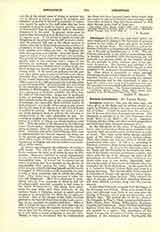

Decapolis (from Gr. Deka, ten, and polis, city), the name given in the Bible and by ancient writers to a region in Palestine lying to the east and south of the Sea of Galilee. It took its name from the confederation of the ten cities that dominated its extent. The Decapolis is referred to in the New Testament three times: Matt., iv, 25; Mark, v, 20; vii, 31. Josephus, Ptolemy, Strabo, Pliny, and other ancient geographers and historians make frequent reference to it.
At the disruption of the army of Alexander the Great, after his burial at Sidon, great numbers of his veterans, their occupation gone, settled down to a life of peace. The coast towns being already peopled, many of the Greeks sought homes farther inland. There they either laid out new cities or rebuilt and transformed older ones. In 218 B.C., according to Polybius, several of these towns were looked upon as strong fortresses. As long as the Seleucidie ruled in the North and the Ptolemies in the South, the influence of the Greeks remained paramount in Syria; but when, with the rise of the Romans, the power of the descendants of Alexander‘s soldiers weakened, the Greek cities were in sore straits. Especially perilous was the plight of these towns in Palestine after the successful rise of the Machabees. In the years 64-63 B.C., however, Pompey overran Syria and made it a Roman province. The Grecian cities, being regarded as bulwarks of Roman rule against any native uprisings, were granted many favors. They enjoyed the right of coinage, preserved their municipal freedom, and were allowed a certain sway over the near-by country.
It was after Pompey’s conquest that the league of the Decapolis was formed. There is no record of the year, and although most likely it was soon after the coming of Pompey, yet it may not have been until Herod‘s time. The earliest list of the ten cities of the Decapolis is Pliny’s, which mentions Scythopolis, Pella, Hippo, Dion, Gerasa, Philadelphia, Raphana, Canatha, and Damascus. Later, Ptolemy enumerates eighteen cities, thus showing that the term Decapolis was applied to a region. The importance of this league was greatly strengthened by the advantageous positions of the principal towns. Scythopolis, the capital of the Decapolis, lay at the head of the plain of Esdraelon, to the west of the Jordan, guarding the natural portal from the sea to the great interior plat-eau of Basan and Galaad. The other cities were situated to the east of the Jordan on the great routes along which passed the commerce of the whole country. Today the cities of the Decapolis, with the exception of Damascus, are deserted and in ruins. Yet even in their ruined state they offer a striking contrast to the near-by cities of the Semites. Their temples, theatres and forums built on a lavish scale, give even to this day clear indication of the genius of the people who built them.
Among the cities of the Decapolis of special interest are: Damascus, so often referred to in the Old and New Testament; Gadara, on the Sea of Galilee, whose inhabitants were the Gerasens of the Evangelists whose swine were driven by the devil into the sea; and Pella, the city in the valley of the Jordan to which the Christians withdrew at the first siege of Jerusalem.
JOSEPH V. MOLLOY

